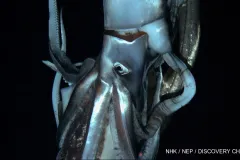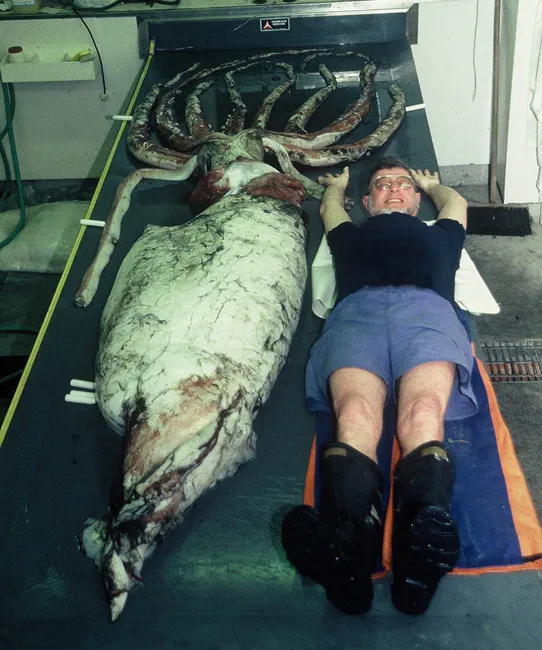Reflections on the Successful Search for the Giant Squid

I have been at the Smithsonian’s National Museum of Natural History since 1966, studying and reporting on all kinds of octopuses and squids. But I’ve always had a particular fascination with the mysterious and elusive giant squid. My interest in giant squid began in graduate school when my professor showed me two small, incomplete, stinky specimens—some of the few specimens in the world at that time. We knew virtually nothing about their biology, behavior, habitat: it was all a great mystery.
My own search for the giant squid began not long afterwards, when I took the opportunity to dissect a huge sperm whale that had washed ashore on Jupiter Beach, Florida. Since sperm whales were known to be the major predator of giant squid, I hoped to find a specimen of giant squid in its gut. But in spite of dissecting and crawling inside the whale’s three (!) stomachs, I found no evidence of a giant squid inside. However, there were tell-tale, large, circular scars around the mouth and head of the whale—clear evidence left by the powerful suckers of giant squid, as they struggled to escape from the vice-like, hungry jaws of the whale.
Since that day, I have maintained a special interest in giant squid. In the mid-1970s, I brought a washed-up giant squid, a bit ragged and damaged, back to the museum where it was on display to the public for 25 years. (With the construction of the new Sant Ocean Hall, we replaced that old specimen with two new specimens in excellent condition from Spanish waters.) By the late 1990s, the public had become so fascinated with the giant squid that I began to wonder if we could possibly find and film a living giant squid in its natural habitat.
The first opportunity came when National Geographic Television came knocking on my door with their new underwater video camera system, the “Crittercam”. We decided to go to Kaikoura Canyon, New Zealand where the squid’s predator, the mighty sperm whale, lived. So, off we went to New Zealand anticipating that we would get video footage of a whale chasing and capturing its huge prey at home in the deep sea. We saw many rare and unusual deep-sea animals, but no giant squid.
A couple years later, Discovery Channel sponsored my second expedition to New Zealand in search of a living giant squid. We dove right into the habitat of sperm whales and giant squid with a small, single-person, submersible equipped with multiple cameras and lights. A cable linked the sub with the surface ship so that those of us who remained onboard could watch in excitement and anticipation as the vehicle slowly swam along in the deep-sea haunts of the giant squid. But we were hit with a furious storm that raged for several days, preventing us from returning to sea before our time was up. We had to go home empty handed again.
Why in the world are giant squid so hard to find and film alive in their natural habitat? Giant squid are probably not rare, as was once thought. In fact, since sperm whales regularly feast on them, giant squid must be quite abundant, perhaps numbering in the many millions within the ocean’s vast inky depths. But they are hard to find because they occur at depths where it is challenging and expensive to work.
Those of us who have sought the living giant squid for so many years probably are the most excited, most congratulatory and most relieved of anyone else in the world that the giant squid finally has been captured on film—alive and well—and even feeding on a big calamari bait that helped attract her to the cameras! Finally the hunt is over, the spell is broken, the world is informed.


